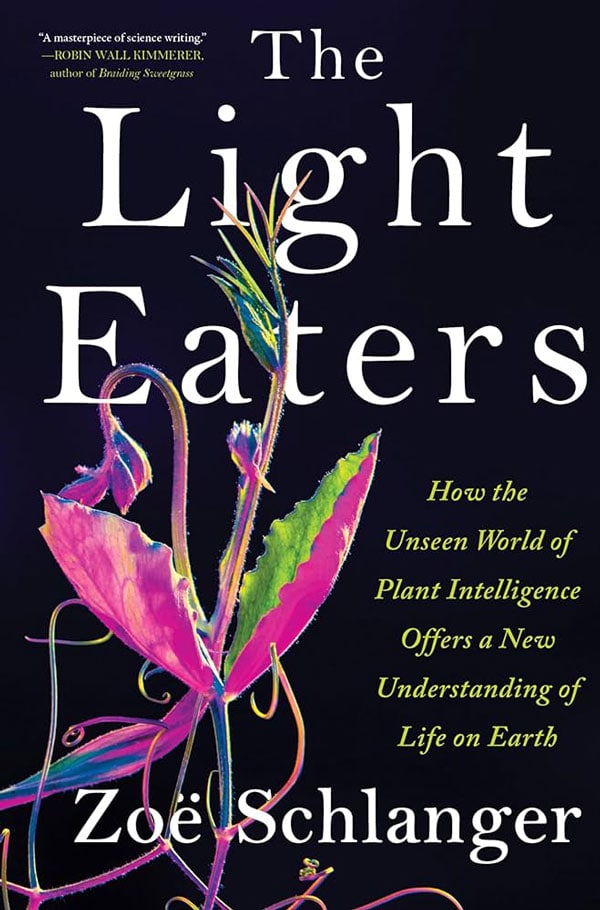A Compelling New Look at Plant Intelligence
In the prologue to The Light Eaters, author Zoë Schlanger invites us to the Hoh Rain Forest in Olympic National Park west of Seattle, Washington. There she meditates on the profound connections between life forms, from the microscopic to the macroscopic, describing it as “a sort of balance in constant motion.” And so begins a book about revelations and wonder, from the perspective of a writer experiencing a joyful shift in her journalistic focus from the often grim narratives of climate change to the more creative and life-affirming topic of plants.
Schlanger’s story begins with a tiny fern, specifically Azolla filiculoides. It’s one of the world’s smallest, and she’s captivated not only by its delicate appearance but also by its incredible evolutionary and ecological significance. She recounts how this same fern (which she later decided to have tattooed on her arm) grew in vast blankets over the Arctic some 50 million years ago, absorbing incredible amounts of CO2. Her experience of it today, glowing “so green it looked lit from within,” turned momentary attention into awe and reverence for this tiny yet mighty plant. It starts her on a journey of exploration that is both scientific and poetic, into the often underappreciated realm of plant life, and to challenging long-held notions about plant consciousness and capabilities.
Beyond being an all-around good read, The Light Eaters explores the profound and often overlooked capabilities of plants, inviting readers into a world where plants are not just background elements but active participants in Earth’s ecosystem. The book combines elements of scientific inquiry, philosophical reflection, and personal narrative to delve into topics like plant consciousness, the complexity of plant behaviors, and the interconnectedness of life.
My own perspective on environmental literature had me wondering how Schlanger would handle the “plant intelligence” debate. It’s been fraught with misinformation and bracketed by accusations of misplaced anthropomorphism on one end and the need to eliminate some very out of date assumptions on the other. She handles this deftly, in a way that should be very satisfying to anyone curious about whether plants have “consciousness.” While praising the scientific community as a whole, she notes that arguments against assigning normally human traits to plants are stuck in a quagmire of circular reasoning.
And she goes deeper into how the mysteries of plants are confounding centuries-old notions. “The more botanists uncovered the complexity of forms and behaviors of plants,” she says, “the less the traditional assumptions about plant life seemed to apply. The scientific field was eating itself alive with contradictions, points of contention multiplying as fast as the mysteries.” (Since I also just finished reading Jason Roberts’s new book on the history of scientific classification, Every Living Thing, this all rings true.)
Schlanger’s careful language and thoughtful exploration of these difficult concepts combine for a very good read. But the book becomes even more enjoyable when she begins to explore plant behavior and biology on an everyday level. For example, what happens when a plant — for the most part frozen in place for most of its life — comes under attack by caterpillars? Despite what some would say, it’s not a simple battle of winners versus losers:
“It is not, then, in the plant’s interest to completely destroy the grazing caterpillars that will metamorphose into the very creatures it relies on to spread its pollen. But likewise the plant cannot bear total leaf destruction; without leaves, the plant can’t eat light, and it will die.”
So what the plant does, she notes, is respond by generating noxious chemicals that discourage further foraging by the caterpillars. There are no real losers. These species have been cohabiting the same places on the planet for millions of years and worked out how to both help one another and draw limits. Beyond the crisp but inventive writing, it’s these kinds of careful illuminations that make the book feel so worthwhile.
Perhaps this book’s most important strength is its potential to shift paradigms—encouraging us to think about plants not just as background elements in our environment but as dynamic, intelligent entities. While not an instant cure for human plant blindness, it will certainly help lower the odds that we view plants in the landscape as merely a “green smudge. This is also a book that might change how you walk through a forest, how you view the plants in your own backyard, and maybe even instill a greater reverence for these most common of non-human cohabitants. The Light Eaters will resonate with a wide range of readers, leaving them with a renewed sense of wonder for the green beings that share our planet.

